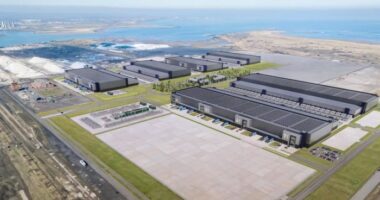Share this @internewscast.com
In Washington, D.C., on Friday, November 7, 2025, a significant gathering of nuclear experts convened, organized by Third Way and The National Interest. The focus of the meeting was on exploring the pathways for the United States to rebuild and strengthen its global partnerships in the nuclear sector. While some participants hesitated to call the current situation a “nuclear renaissance,” a term popular in the 2000s before the shale boom and the Fukushima disaster in 2011, there was optimism about a potential nuclear revival or revitalization. This optimism stems from expectations of substantial development both domestically and internationally. The Trump administration has issued several executive orders to bolster nuclear energy, while Europe is also experiencing shifts in nuclear policy. However, a critical question remains: can the United States accomplish this independently?
The consensus is clear: the United States cannot achieve this goal alone. To have operational reactors by 2030, the U.S. will require international collaboration at every level. From supply chains to technology access and immigration policies, cooperation is essential. The human element is crucial, as reactors are built by people, and without this workforce, plans will remain theoretical. Miriam D’Onofrio, Senior Director at X-energy, highlighted the importance of three C’s: commitment, consistency, and complementarity in domestic policy. Currently, commitment is evident, with the administration’s executive actions and global leaders pledging to triple nuclear capacity by 2050. Furthermore, the World Bank and 14 other financial institutions have lifted the longstanding informal ban on financing nuclear projects.
Nuclear Needs Three C’s: Commitment, Consistency, And Complementarity
However, the consistency aspect raises concerns among international partners. The current U.S. administration shows a preference for bilateral agreements rather than broader multilateral frameworks. This is not solely an American issue; many countries experience shifts in nuclear policy with each election cycle, leading to what some describe as policy whiplash.
Complementarity is crucial for alliances, and Canada stands out as a natural partner. With its uranium resources, operational reactors, and advancements in small modular reactors (SMRs) such as the BWRX-300 at Darlington, Canada fills significant supply chain gaps. The UK also fits into this collaborative framework. The aim is to align countries that can complement each other’s strengths and weaknesses in the nuclear sector.
While the U.S. may strive for the three C’s domestically, growing competition seems more likely, especially as global nuclear markets divide into eastern and western blocs. Nuclear companies operate on long-term timelines, but shifts from cooperation to competition can happen rapidly. For instance, the U.S. once collaborated with China on a TerraPower project to develop a sodium-cooled fast reactor. However, current U.S. policies now restrict exporting advanced reactor technology to China. Jeff Navin from TerraPower pointed out how close the two nations were to sharing blueprints, a possibility that vanished almost overnight with changes in industrial policy.
The Fourth C: Competition Between Eastern And Western Nuclear Markets
Today, the global nuclear landscape is divided into two primary markets. One is led by China and Russia, while the other comprises the United States, France, other European nations, and Canada. South Korea finds itself in a unique position; it is a Western ally with strong U.S. industrial ties but also competes fiercely in global reactor markets with a state-supported model. South Korea has established a government entity focused on developing SMRs. Unlike the eastern model, which follows a clear national strategy, the western model depends heavily on private developers navigating through fragmented policy directions.
The world today is split into two broad nuclear markets. One is anchored by China and Russia. The other includes the United States, France and the rest of Europe, and Canada. South Korea sits somewhere in the middle. It is a Western ally with deep U.S. industrial ties, yet it also competes aggressively in global reactor markets with a state-backed model. South Korea has even created a government-established entity dedicated to developing small modular reactors. The difference is that the eastern model operates under a clear national strategy, while the western model still relies heavily on private developers navigating fragmented policy signals.
Yet nuclear companies are not selling reactors for quick profit. They are creating long-term bonds between countries that last for the entire life of a plant and often beyond, cementing 80- to 100-year relationships. The U.S. nuclear relationships with other countries are also governed by Section 123 of the U.S. Atomic Energy Act, the so-called 123 Agreements. In essence, the U.S. is saying, “We can work with you on nuclear power, but only if you meet our nonproliferation standards.” Once the agreement is in place, U.S. companies can sell reactors, fuel, parts and services, and they can share designs and technical expertise. Without a 123 Agreement, they legally cannot, which makes the process slow, political and very visible.
Several countries are becoming long-term partners to the United States. The view shared in the room was simple: “if we fight, we are going to lose together.” South Korea and Westinghouse have resolved their past IP disputes, and Japan is emerging as one of the more stable nuclear partners for the United States. There is also ongoing collaboration with Australia on SILEX, a laser-based enrichment technology. Silex Systems and Global Laser Enrichment are jointly advancing the SILEX enrichment technology, with work taking place in Sydney as well as at GLE’s facilities in Wilmington, North Carolina, and Paducah, Kentucky.
Poland, a top-20 global economy with extraordinary GDP growth of 800% over the past three decades, is moving ahead with its National Nuclear Energy Strategy to build its first nuclear plant in Pomerania using the AP1000, a US-reactor. Poland has approached the European Commission for state-aid approval and the United States for debt financing.
Still, too often the U.S. companies arrive with a reactor design and a set of PowerPoint slides, and the foreign partner is left trying to piece together how to build one of the most complex projects in modern engineering. Russia shows up with something very different: a full package that includes the design, the financing, the construction and operations teams, the fuel and even the promise to take back the spent fuel. Recently, Egypt and Vietnam engaged Russia in new nuclear-energy cooperation agreements or negotiations. Such deals function like a virtual pipeline that Russia no longer has to build to exert influence.
Nuclear Revival Depends On Financing, Jobs, And AI
The U.S. has invested heavily in RD&D and promotes domestic technologies through buy-American rules, but most of the companies developing new nuclear technologies are still startups, even if their valuations are in the billions. And we should not expect them to sort out electric rate structures or absorb the political fallout that comes with those decisions. That is the mandate of public utility commissions, while the companies themselves simply need to be good grid citizens as they pursue their own bottom lines.
You cannot talk about nuclear without talking about data centers. It is increasingly plausible that nuclear power and AI data centers will be co-located over the next decade, given the direction of current demand. And if that happens, the financing should come from private capital rather than rate-payers. Yet the financing puzzle remains: nuclear startups may raise billions in equity, but that does not translate into project finance. Even more striking, the United States has never had a PPA that directly led to the construction of a new nuclear plant. First-of-a-kind (so-called FOAK) projects come with staggering uncertainty and risk, and financing becomes the bottleneck. As the saying goes, the first car off the assembly line costs a billion dollars.
The path out of this problem is an orderbook. When you build the same reactor repeatedly, unit costs fall. But orders come only after the first successful delivery, which makes this a classic chicken-and-egg problem. Even if the media focuses on the high cost of FOAK at Vogtle, it often forgets that the second unit came in much cheaper. But orders still depend on the first successful delivery, and that remains the core bottleneck.
The experts noted that in the past, nuclear meetings were mostly attended by people from within the industry. Now the mix looks different. “Lawyers and financiers are showing up to nuclear conferences, dirt is being moved. Opportunity is not only there, but we will be strongly delivering on this opportunity,” said John Kotek, Senior VP at the Nuclear Energy Institute.
High electricity demand from AI is keeping electricity price expectations up, which helps nuclear. Over the long term, the nuclear industry still has to find a way to bring costs down. Those reductions may come from places the sector has not traditionally looked. “Robotics and AI for welding automation could lower U.S. construction costs and even put the U.S. in a position to outbuild China”, said Hyun Kang, Professor of Nuclear Engineering at Rensselaer Polytechnic Institute.
Another way the nuclear industry can strengthen its position is by building community acceptance through real workforce commitments, especially in coal communities where plant retirements often coincide with mine shut-downs. That double hit can be devastating. Jeff Navin noted that TerraPower has engaged a coal town in Wyoming with a proposal that would bring 200 to 250 well-paid union jobs to the new plant. Conversations with the mayor suggest the community has welcomed the idea. And it is worth remembering that nuclear jobs are not only white-collar jobs. Alongside the engineers, there are hundreds of construction roles during the buildout and security jobs once the plant is operating.
If Nuclear Is a Printer, Fuel Is the Cartridge. We Need More Cartridges.
There is a familiar saying in the industry that if a nuclear reactor were a printer, uranium fuel would be the cartridge. You cannot print without it. The United States needs a viable supply chain outside of Russia, which means building an integrated American fuel cycle and tightening partnerships abroad. The U.S. has already enacted a ban on Russian uranium imports, with limited waivers available through 2027 and a full prohibition taking effect on January 1, 2028. This puts pressure on the U.S. to expand domestic mining and enrichment capacity, and the market will still need to address potential circumvention routes, where Russian-origin material is blended or rerouted through intermediaries.
As Jennifer Dunn of URENCO USA noted, the company has no concerns about a shortage of uranium supply. URENCO already meets roughly one-third of U.S. enrichment demand through its commercial-scale facility in New Mexico, right on the Texas border. The plant represents a five-billion-dollar private investment, built entirely without government funding, and supports about 500 American jobs. It is regulated by the NRC and has been authorized to produce HALEU, with first deliveries are expected in 2027. The New Mexico facility is adding 2.5 million SWU of new capacity by 2030. This being said, the advanced fuel market is still in its infancy, and its future size is uncertain. URENCO also operates three European enrichment plants and one in the United States, which allows the company to manage both market and geopolitical risks.
There are other prominent players in this landscape. Cameco, based in Canada, is one of the world’s largest publicly traded uranium miners. Westinghouse is replacing Russian fuel in several markets, including Ukraine, which has relied heavily on Russian-designed reactors.
The United States is not short on reactor designs, talent or ambition. What it needs now is the political will to match its competitors, the financing tools to turn designs into steel, and the partnerships to make the fuel cycle real. Nuclear power has always been a long game, measured in decades, not election cycles. A long-term nuclear revival will not happen without allies and a strategic national plan.














